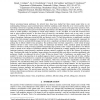Free Online Productivity Tools
i2Speak
i2Symbol
i2OCR
iTex2Img
iWeb2Print
iWeb2Shot
i2Type
iPdf2Split
iPdf2Merge
i2Bopomofo
i2Arabic
i2Style
i2Image
i2PDF
iLatex2Rtf
Sci2ools
HVEI
2010
2010
Preference for art: similarity, statistics, and selling price
Factors governing human preference for artwork have long been studied but there remain many holes in our understanding. Bearing in mind contextual factors (both the conditions under which the art is viewed, and the state of knowledge viewers have regarding art) that play some role in preference, we assess in this paper three questions. First, what is the relationship between perceived similarity and preference for different types of art? Second, are we naturally drawn to certain qualities--and perhaps to certain image statistics--in art? And third, do social and economic forces tend to select preferred stimuli, or are these forces governed by non-aesthetic factors such as age, rarity, or artist notoriety? To address the first question, we tested the notion that perceived similarity predicts preference for three of paintings: landscape, portrait/still-life, and abstract works. We find that preference is significantly correlated the first principal component of similarity in abstract wo...
| Added | 07 Dec 2010 |
| Updated | 07 Dec 2010 |
| Type | Conference |
| Year | 2010 |
| Where | HVEI |
| Authors | Daniel J. Graham, Jay D. Friedenberg, Cyrus H. McCandless, Daniel N. Rockmore |
Comments (0)

